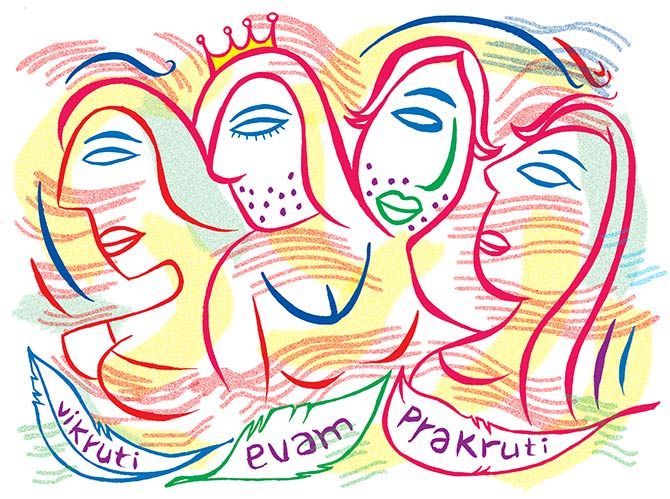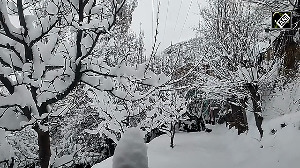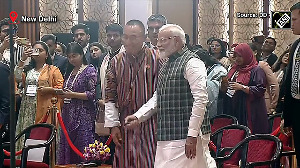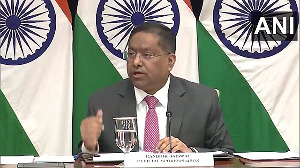Devdutt Pattanaik, who has simplified ancient Indian scriptures for millions of readers, highlights what our scriptures have to say about homosexuals and transgenders.
Illustration: Uttam Ghosh/Rediff.com

Ancient scriptures from the subcontinent have variously discussed sexuality in general and queer expressions in particular.
Indeed, these may perhaps be the earliest attempts to describe human sexuality and identity in naturalistic terms that approach a scientific articulation.
Some of the more prominent examples of these include the Sushruta Samhita from 600 BC, the Caraka Samhita from around 200 BC, the reflections of Narada in the 1st century BC and the most famous Kama Sutra from the 6th century AD.
The Sushruta Samhita lists several types of men who are impotent with women, referred to as kliba, and goes into great detail regarding their distinguishing features in sexual attraction.
It asserts that the homosexual asekya is conceived as a result of the father’s semen being scarce and he therefore enjoys swallowing the semen of other men.
The transgender shandha is conceived when the mother plays the dominant role during intercourse (purushayita or 'woman on top').
The text goes on to assert that all three natures -- male, female and the third sex -- are determined at the time of conception.
The Caraka Samhita, which is an ancient Vedic medical text, lists eight types of men who are unable to copulate with women.
1. Dviretas -- born with both male and female 'seed'
2. Pavanendriya -- unable to discharge semen
3. Samskaravahi -- aroused according to previous life impressions
4. Narashandha -- manhood is completely destroyed
5. Narishandha -- womanhood is completely destroyed
6. Vakri -- penis is severely curved or deformed
7. Irshyabhirati -- aroused only by seeing others in the act of sexual union
8. Vatika -- born without testicles.
The text asserts that these variations are produced by unchangeable factors such as previous life impressions, parental conditions and certain conditions within the womb.
It is thus one of the earliest claims in the world of a biological basis for homosexuality
In the Narada-Smriti, the sage Narada identifies 14 different types of men who are impotent with women.
These include the mukhebhaga (men who have oral sex with other men), the sevyaka (men who are sexually enjoyed by other men) and the irshyaka (the voyeur who watches other men engaging in sex).
All three types are declared unchangeable and are forbidden from marrying women.
The Kama Sutra, composed by Vatsyayana, is the most famous ancient text that deals most freely with desire.
It accepts sexual activity as the central theme of our lives as human beings and gives desire, particularly the desire of the body and senses, its rightful place as a human activity.
The text can be said to be more worldly-wise and inclusive.
For instance, in its discussion of oral sex between men, the Kama Sutra uses the term tritiya-prakriti (third sex or third nature) to define men with homosexual desire and describes their practices in great detail.
It divides such men into two types: Those with a feminine appearance and demeanour and those having a manly appearance with beards, moustaches, muscular builds and more.
The Kama Sutra also mentions homosexual marriages based on 'great attachment and complete faith in one another'.
Women who are impotent with men are mentioned less frequently in Vedic literature.
Nevertheless, at least 10 different types of third-gender women can be found in various Sanskrit texts.
The Kama Sutra does mention the svairini (an independent woman), who engages in aggressive love-making with other women.
Lesbians and women who are masculine are mentioned for their skills as businesswomen (vaisyas), armed military guards, domestic servants and courtesans.
Bisexual women, kamini, are described as those who enjoy love-making with both men and women.
Some other descriptions of women found in Sanskrit texts are stripumsa, a woman with masculine behaviour and form, and shandhi, a woman who is averse to men and has no breasts.
Interestingly, the Kama Sutra emerges at a time when monastic Buddhism wanes across the subcontinent and Vedic Hinduism -- with its penchant for festivities, rituals, social engagement and exchange -- enjoys a resurgence through the construction of Hindu temples.
Many of these temples openly celebrate erotic imagery and sexuality in their architecture, including many that depicted homosexuality.
The temples of Khajuraho and Chapri are striking examples of this.
One of the sculptures at the Visvanatha temple of Khajuraho depicts a monk gently caressing a layman.
In fact, many of these temples and their priests nurtured an ecosystem of bustling trade, theatre, art and sexual exploration in the surrounding communities.
These temples were seen as celebration of life, light and kama, from which comes all of creation. A temple devoid of the depictions of sexuality and sensuality was considered inferior and tantamount to the 'lair of death' and darkness.
These facts indicate, at the very least, that sexual diversity and gender-fluidity were recognised as an evident feature of the world and its discussion or depictions were not considered taboo.
Under Tantric Hinduism, according to which semen retention was thought to engender supernatural or magical powers, third-gendered individuals were considered to hold special powers to bless or curse others.
Their powers were proactively sought by members of the heterosexual community for special occasions like blessing a newborn or sanctifying the marriage of newlyweds.
In some instances, the ancient books seem outright progressive in their protection of homosexuals and the third-gendered from abuse by the general public.
The Arthashastra instructs parents to provide the basic necessities of food and clothing to their third-gender offspring and not neglect their needs.
It goes on to state that in cases where there are no relatives, the king must assume responsibility for such individuals.
The Arthashastra also declares it an offence to vilify or publicly mock any person of the third gender and lists various punitive fines for such offences.
Even among the gods, there are a few examples of explicit homoerotic intimacy.
Among the most popular stories is that of the water gods, Varuna and Mitra.
In the ancient scripture of the Shatapatha Brahmana, Mitra is described as 'implanting his seed' into Varuna on every new moon night in order to secure the moon's waning.
The text reads like a gentle ode to the moon recited in terms of a homosexual union.
Another account from the Skanda Purana involves the fire-god Agni, who on one occasion swallows the semen of Shiva while disguised as an ascetic.
In a narrative found in both the Padma Purana and Krittivasa Ramayana, the god Shiva commands two queens to make love with each other, after which they conceive a child.1
Notably, the deep and intimate same-sex attachments between the gods and their devotees are often described in great detail.
Some Hindu scriptures describe these attachments in terms stronger than that held for family members, spouses or anyone else in the entire world.
So, while we can admit that in pre-colonial sub-continental thought, homosexuals did not share an equal status with heterosexual counterparts, the evidence suggests that homosexuals and gender-queers were widely recognised.
Their existence was acknowledged and studied.
They were at the least tolerated if not accepted as an expression of natural diversity in the world.
This view is further validated when placed within the larger metaphysical narrative of Hinduism articulated in the Rig Veda: vikriti evam prakriti, which means that what seems unnatural is also natural, or diversity is nature.
Excerpted from I Am Divine So Are You by Devdutt Pattanaik, with the kind permission of the publishers, Harper Collins India.









 © 2025
© 2025